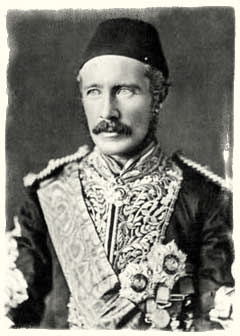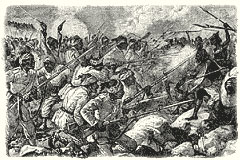
December 1883: “Chinese Gordon” Pulls it Off!
General Baker advanced upriver from Atbara, encountering little resistance from the local tribes until a determined effort was made by about 1500 insurgents to contest his traversing of the 6th cataract north of Wad Hamed. The enemy position was carried with only minor casualties and the town occupied shortly thereafter. Baker’s Abyssinian scouts pushed forward to reconnoitre the situation at Khartoum, returning to report a fierce battle, taking place around the northeast gate of the city.

Despite Burnaby urging immediate action, Baker decided that discretion was the better part of valour, wishing to await confirmation of the exact situation in the city before committing his expedition to battle against overwhelming numbers of rebels.
There is further good news for Baker – during a recent debate in parliament, Lord Abercrombie, the Minister for War, has been fulsome in his praise for Baker’s actions during the campaign – an indication, maybe, that there is, at last, a chance for his restoration in society should he continue to perform his duties well.
Gordon’s audacious plan to disrupt the enemy siege and secure fresh supplies for the starving inhabitants of Khartoum was a resounding success, but a close run thing. A diversionary attack by the Egyptian brigade on the enemy lines drew the savage hordes away from the Nile, allowing Gordon to personally lead an amphibious assault, seizing and holding the ruined fort by the river, while his Sudanese infantry stormed ashore to seize supplies. During this action the enemy artillery battery guarding the landing point was silenced by deadly accurate fire from the gunboat, and Gordon participated in desperate hand to hand fighting as the Dervishes sought to recapture the fort and cut off the shore parties from escape.
After driving off attacks by both Dervish infantry and cavalry, several over-excited Egyptian units found themselves dangerously exposed in the face of overwhelming enemy numbers. A desperate retreat back to the safety of the city ensued, in which the (jammed) Gatling guns were abandoned, and casualties would have been far more serious had it not been for a suicidal charge by the Egyptian cavalry into the pursuing enemy units. In the ensuing melee, the cavalry were cut down to the last man, with only Colonel Stewart and his batman managing to cut their way through the enemy hordes, concealing themselves upon the battlefield and ultimately returning to the city after nightfall by a circuitous route, definitely ‘shaken but not speared’.
Cautiously navigating the narrow channel through the mud banks, the Fashoda returned to the city carrying not only the exhausted Sudanese and an exuberant (& rather ‘tired and emotional’) Gordon, but also enough supplies to sustain the city for another two months on half rations.
Wolseley has advanced south to relieve Dongola, storming enemy entrenchments at Suarda, surviving an ambush of the column at Kerma and beating off a dawn attack on the zeriba a few miles from Dongola itself. During the latter, the general had a lucky escape, when a stray round holed his pith helmet, but other than that, casualties were light. Dongola, the Mahdi’s home town, is now secure, defended by a single half company, while the rest of the garrison, including the gunboat Metemmeh, has been incorporated into the expeditionary force, now encamped at Debba.
The British expeditionary force under General Graham has been held back in Aden, in order for the newly arrived Royal Irish to acclimatize. At one point over 1 man in 5 in the regiment was hospitalized, suffering from heat stroke or dehydration, but the unit is now back up to strength and ready for action.
Readers may gain some insight of the situation from knowing that at the start of January 1884 supplies at Khartoum have been almost exhausted and the city will fall if a relief column does not drive off the besiegers. With the Mahdists having also accumulated 213 out of 400 victory points needed for victory, a defeat with heavy losses could well see the end of the campaign with the Mahdi triumphant as the Anglo-Egyptian commanders have precious few reserves available already in the theatre.

January 1884: The plan for the Relief of Khartoum
Colonel Stewart, ADC to the Governor, General Gordon, has brought the gunboat ‘Fashoda’ downriver with encouraging news – the raid on the Mahdist lines encircling Khartoum successfully brought urgently needed supplies into the city, which can now hold out for a few more weeks if necessary. Valentine Baker is now determined to advance from Wad Hamed to relieve the besieged garrison before British forces under Wolseley and Graham can intervene.

A brigade of Egyptian cavalry commanded by Tewfiq Bey has reinforced the relief column and the Fashoda will provide invaluable additional artillery support as the column advances upriver. It is not enough simply to reach the city – it is essential that military defeat is inflicted on the main rebel army and that they are driven away from the city with heavy casualties.
It is to be hoped that Gordon will impress upon the naturally cautious General Hicks the need for a decisive intervention – a further sally from the city with his infantry (approximately 1500 men) to combine forces with the relief column before a joint attack on the enemy lines to drive off the Mahdist hordes.
Baker is advancing south, upriver towards Khartoum, in an open square formation with the allied Watusi levies bringing up the rear. Meanwhile, Gordon has ordered Hicks to prepare to sally out from the city and march north as soon as the relief column is sighted, in order to combine forces and break the siege.
The enemy army encamped in the hills and scrubland around Khartoum is estimated to number between fifteen and twenty thousand men, mainly infantry but with some cavalry, who are well supplied with captured rifles and several artillery pieces…
One thought on “Fire & Sword in the Sudan: December 1883-January 1884”